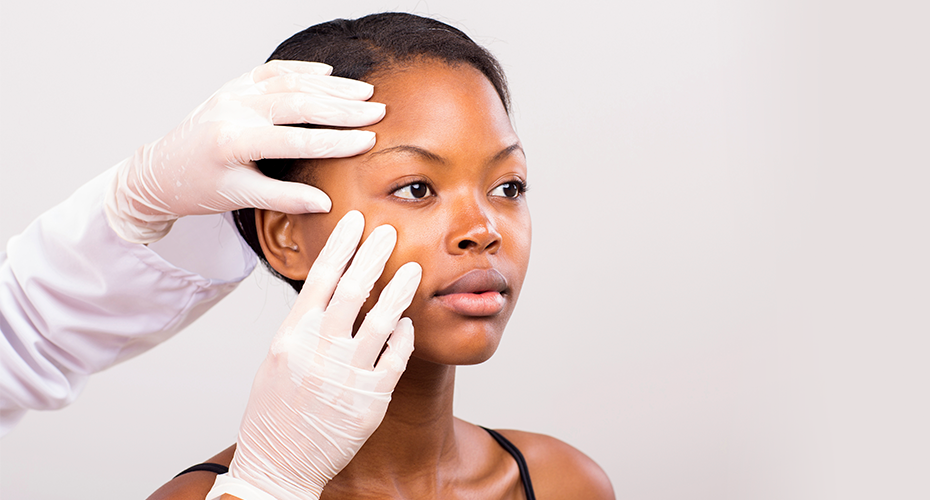Jul 20, 2023
Lessons from a dermatologist
Coverage is proud to publish a monthly column featuring the important perspectives of Black women physicians who belong to the Diva Docs network in Greater Boston. Today, Dr. Jennifer Jenkins, a dermatologist, shares her thoughts with Dr. Philomena Asante, leader of Diva Docs Boston and creator of the Diva Docs series for Coverage.
Years ago, when I was in medical school, I met the chair of the dermatology department, who changed my life.
He was an African-American physician with a passion for mentoring and sponsoring dermatologists and young students. He knew I had an interest in dermatology and pathology and he was intentional about encouraging me, and about exposing me to clinicians and clinical experiences that shaped my professional life. It’s a competitive field, one where you need to know what you want early, and you need sponsors who can guide you.
My mentor helped guide me into a career where, merely by existing, I am a pioneer.

In America, only 3% of dermatologists are African-American. I am often the first physician of color my patients have seen, the first to have closely studied skin of color, the first to understand what it means to grow up with skin of color.
I am the first physician in my family, and I traveled far to get where I am. My patients travel too. They travel miles, some driving an hour to see me. And they travel across history, and trauma. Some share with me their long mistrust of the health care system, the times they have been misunderstood, misdiagnosed.
I see whole families sometimes, and like a family physician, I take the time to sit and listen to their histories and experiences before we address the health concerns that bring them to me that day.
I see patients of every age, from babies to the elderly. I examine my patients for skin cancer, and guide them through treatment. I diagnose and treat eczema, psoriasis, alopecia and acne and many other conditions.
Our skin is as crucial to health as any other organ, and as vulnerable to disparities in care.
Although skin cancers are less prevalent among people of color, when they occur, they are often diagnosed at a later stage. That means a worse prognosis. Cutaneous melanoma, which accounts for 75% of all skin cancer deaths, has a 98% survival rate when caught early, but one study found only 58% of Black people had a five-year survival rate. Black patients with melanoma often suffer “deeper tumors, more advanced stages of disease and higher rates of ulceration,” another study found. Nearly 10,000 people a year die of the disease each year.
Researchers have found other disparities in my field. A JAMA study recently found that even though Black patients are more likely to seek care from a dermatologist, they were less likely than white patients to be prescribed medication for acne, which can cause scarring and has been linked to depression.
So how can patients advocate for themselves?
- Request a full body check and make sure the doctor examines the palms of your hands and the soles of your feet, where melanoma is more likely to develop in patients with darker skin tones. Your dermatologist should also check for pigmented or red lines in your nails or other nail abnormalities. The notion that Black skin doesn’t suffer from sun damage is a dangerous myth. Always wear a broad spectrum SPF 30 or higher outdoors!
Discuss hyperpigmentation. Dark spots or hyperpigmentation can be caused by inflammation from acne or a preceding rash. Larger patches of melasma may occur spontaneously or related to sun exposure, medications, or pregnancy. The key fact about hyperpigmentation is that it is best addressed early. The more longstanding the discoloration is, the more difficult it can be to rid the skin of it.
Some common practices can worsen hyperpigmentation. For instance, exfoliation or irritating procedures or cosmetics can cause more inflammation and subsequent pigmentation. Some patients use hydroquinone or skin lightening agents incorrectly and this can actually worsen the problem of hyperpigmentation, making skin darker, a condition called ochronosis, which is often permanent.
Some “fade creams” or “skin brightening” products sold online or in local shops are contaminated with ingredients that should not be applied to the skin, including mercury or high-potency topical steroids like clobetasol, which may damage the skin. It’s important to talk to your dermatologist about safe, reputable products.
Ask about acne: Women of color often have comedonal and cystic acne, which is acne under the skin. It can occur into middle age, and it can cause scarring. It should be treated aggressively. There are online dermatology stores and at malls that are eager to sell you various cosmeceutical products that will not work for deeper acne. Ask your dermatologist about your treatment options.
Some types of acne can be caused by products. For example, pomade acne on the forehead is caused by oil applied to the hair. That oil is commonly used to treat seborrhea, dry scalp, but in fact it worsens the seborrhea and causes the acne. A dermatologist can help you treat the underlying seborrhea with a zinc-based dandruff shampoo or medicated oils. Also be sure to wash hats, weaves and wigs regularly to avoid oil build up against your skin.
- Discuss your hair care. A simple rule: don’t do anything to your scalp that causes itching, redness, inflammation or pain. If hair braiding is so tight that it hurts, it will cause inflammation and damage over the years – damage that may start as a child, but won’t be visible until you’re an adult.
If you have itchy bumps or pain on the scalp, ask a dermatologist to take a look. They could be signs of hair loss, or alopecia. If alopecia occurs, we need to treat the underlying inflammation which can lead to scarring. There’s a misconception that once you start losing hair, there’s nothing that can be done. But if you seek help early, before scarring, there are usually still viable hair follicles, and we can reduce the inflammation and preserve the hair. The earlier and more consistently you treat it, the better the outcomes.
Natural is best and healthiest for our hair and for our skin in general. But historically, Black women have straightened their hair so they could be thought of as more socially acceptable, especially in the workplace. As a dermatologist, I often find myself having a conversation with my patients about the notion that you can wear your hair natural and still be seen as a professional.

The medical establishment’s responsibility
The majority of dermatologists have been trained on patients with lighter skin and may not be familiar with how skin conditions present in patients with dark skin. Medical schools have some real responsibility here: to encourage clinical rotations through communities of color, to provide training in bias, and to ensure familiarity with how skin conditions present across the different hues of skin color. Our academy has been intentional about including photography of conditions in skin of color during our training. But we need more education.
We also need more Black medical students, and more mentors and sponsors of medical students interested in treating skin of color.
Today, I am often the first physician of color my patients have seen. But in another generation, most Americans will have skin of color. I look forward to welcoming more of them into the field of dermatology.
PHOTOS OF DR. JENKINS AND DR. ASANTE BY FAITH NINIVAGGI

